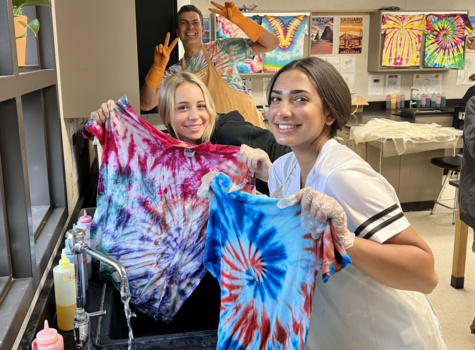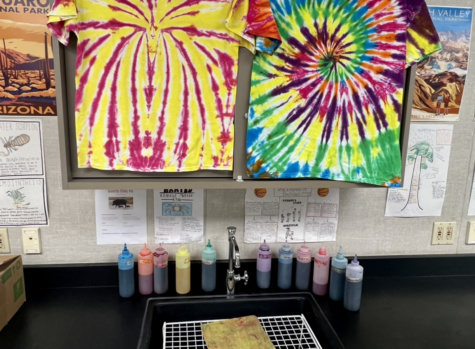
Amanda Dirpes | Writer
May 19, 2023
In the weeks following lengthy finals and dreaded AP tests, wrapping up the school year with tie-dying proves to be the perfect activity to celebrate the close! AP Environmental Science students were given the opportunity by their instructor to bring in a cotton t-shirt to tie-dye while working on a final city-planning project.
“This is the seventh anniversary of the end-of-the-year tie-dying extravaganza! We tie-dye to celebrate the end of a successful school year. It is an artistic opportunity to participate in while students complete an end-of-year project, Just like a beautiful seashell, no two tie-dyes are the same,” AP Environmental teacher Mr. Rasor explained.
The history of tie-dye dates back thousands of years and is found in various cultures around the world. Although tie-dye gained popularity in the United States during the 1960s counterculture movement, its techniques and traditions can be traced back to ancient times. Tie-dye techniques have been used in different cultures throughout history. The earliest evidence of tie-dye can be found in ancient Peru, where fabric dating back to 500-800 AD has been discovered with tie-dye patterns. Similar techniques were also practiced in India, Japan, and Africa. Tie-dye gained significant popularity in the United States during the 1960s as part of the hippie and counterculture movement. It became a symbol of individuality, self-expression, and anti-establishment sentiments. Commonly used on clothing, particularly t-shirts, tie-dye created the vibrant and psychedelic patterns associated with the era. Tie-dye continued to be popular beyond the 1960s and has made periodic comebacks in fashion trends. It has been embraced by various subcultures, such as the rave and festival scenes, and has seen renewed interest in recent years with a focus on sustainable and DIY fashion.

“First, Mr. Rasor soaked our shirts into a baking soda solution to help the dye stick, then we folded and rubber-banded them according to our desired tie-dye pattern, and then we got to choose and apply the colored dye! It was such a fun memory to make during the last few days of my senior year!” Senior Addie Brislen expressed.
What better way to end a creative, unique school year than with an equally creative and unique activity?

I loved this article!!